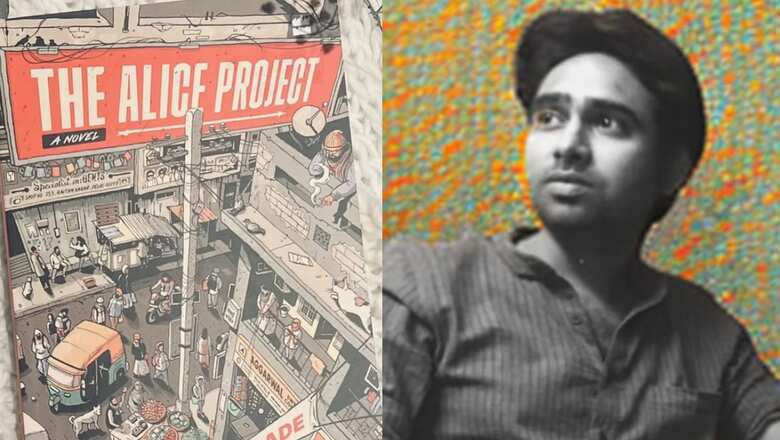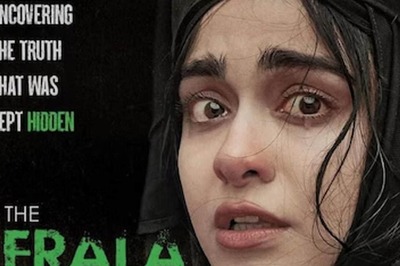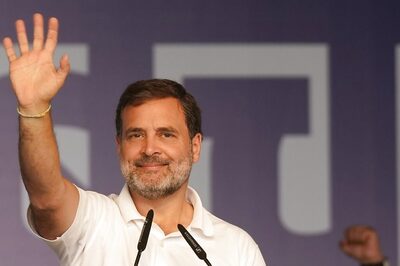
views
Satwik Gade an extremely talented illustrator and storyteller hailing from Chennai literally became the talk of the town with his debut novel, ‘The Alice Project.’ For someone who was making a debut it was rather gutsy to humourise a coming-of-age novel, a lot of people write around it but not too many people dare to experiment with it. His thirst to understand the basic intricacies of life was well reflected in the way he penned down the book leaving one with no surprise that his debut novel was extremely well received.
In an exclusive conversation with NW18, Satwik talks about his debut book, his writing process, his journey as a graphic artist and much more
To begin with, the very title of your book is extremely intriguing. Is there a story behind it, how did you decide on the title?
Yes, there is a funny little story behind the title. The Alice Project was actually the working title of the book when all we had was three chapters and a synopsis. We thought we’d eventually come up with a book title. Initially my editor and I both liked the idea of calling the book “Who the fuck is Alice?”. But somewhere along the very long process of writing the book, I didn’t like the title anymore. I felt that it might put off some readers. Over the last decade I saw a lot of books with cool and edgy titles. But instead of impressing me I found them too clever by half and the names ended up putting me off. So I developed cold feet about “Who the fuck is Alice”. My editor still really liked it and that was the title of my manuscript. So, well after the book was done and cover art was being commissioned, we still didn’t have a consensus on the name. I suggested some alternatives which my editor didn’t think were strong. So as a compromise we decided to go ahead with a name that neither of us particularly liked! ‘The Alice Project’.
You had mentioned in an interview about how this book and the characters in it are slightly autobiographical. Can we talk a little about that?
As a clumsy and absent minded man-child, I always depended on my friends to fill in for my parents both in college and after college. In Delhi we lived in an area which was close to DU south campus, AIIMS, IIT and NIFT. We lived in a residential colony which was, for all practical purposes, a sort of extended hostel. I felt it was also relatively underexplored compared to the north campus that many books and movies are set in. Something that I noticed and wanted to write about was how couples who rented a house together would end up becoming the source of domesticity for all their single friends. So one of the several days when my friend Rupin and I invited ourselves over to my friends Nitish and Harini’s house for lunch, I made some notes: a setting and characters for a slacker comedy: Alice, Bakchod, Nitin and Iyengar. Alice was my roommate’s nickname for me (that never really caught on) since I was always lost in my wonderland. Years later, those notes helped formulate the first chapter of my book. I didn’t even have to refer to the notes. They were vivid in my memory, so I took my continued interest in those ideas as a good sign.
Incidentally, last December, tired of working and frustrated by delays in publishing my book, I dropped my projects in Chennai and landed up at Nitish and Harini’s house in Bombay on a day’s notice. I just lived there for more than a month. And my book got released while I was vegetating in their house and eating their food. My friends from college, most of whom are in Bombay now, still turn up at their house and drink endless cups of chai. Nothing changed and my book is about nothing changing. I felt it was kind of fitting.
So I would say the characters are well rounded not due to any expertise in writing on my part but because they are real people! The incidents, conversations and other characters in the book are all mostly fictional but also amalgamations of various people I have met since and the anecdotes they shared about their lives. So the book is fictionalized but not a hundred percent fiction.
What was the process like for writing The Alice Project, a coming-of-age novel? While the novel incorporates familiar tropes, the overall treatment feels refreshing. Can you share insights into how the book was written to achieve this unique perspective?
I edit a lot! I rewrite every single sentence several times until I get the musicality and rhythm of that sentence right. I write whole chapters that I discard ruthlessly if they feel staid. For the ten chapters that made it into the book I must have written maybe 30 or more chapters. Every sentence in the book has been edited or rewritten about six or seven times. I’d love to pretend like it all just magically happened but it’s really donkey’s work. Another thing I feel is that there is a desperation amongst young writers to be “original”. So when someone really leans into tropes and celebrates them it feels refreshing because generally writers are scared to own that. I always enjoyed the fact that there was nothing new in my book. I had pitched it to the publishers as a book about nothing in two parts. A book where nothing happens. Twice. So I think if it feels refreshing it’s all thanks to my editor, Swati Daftuar, for taking a punt on my story and trusting that audiences would find it refreshing.
Did your skills as a graphic artist come in handy in enhancing the cinematic storytelling of the book?
Perhaps not. For me words are just words. Unlike reading where my imagination is vivid, I cannot visualize my story when I am writing. I focus more on the sizes of sentences and shapes of paragraphs. I don’t know what Alice or Snigdha or anyone else looks like. So if the storytelling is cinematic, I would put it down to the fact that the book is actually inspired by movies. Especially the movies of Richard Linklater. And a lot of sitcoms. Several times in college when we were sitting and talking I’d feel like the world is missing out on some great content because the quirky dialogue and jokes deserved an audience wider than just the bunch of us. So even as our conversations happened I’d imagine them as a scene in a movie or a sitcom. It became a habit and I still do it today! I suppose these things contributed to the cinematic style of storytelling.
Can we talk a little about the illustration that serves as the cover image of the book?
What an illustration, right?! One of my closest friends and college roomie Broti Bhattacharya who is now a hotshot illustrator in Bombay did the cover. I didn’t let him read the book. I just told him “I want Gautam Nagar with a view of Suttah Point.” I know his work so intimately that I was aware that if I kept my prompt intentionally vague and unhelpful he would come up with something amazing. Even though I didn’t specify I knew he would do a three point perspective of the setting and that’s exactly what I wanted. The back cover illustration is intended to attract rom-com nuts. I gave a very specific prompt for that. In fact I sketched out a rough draft and sent it to him. Blasphemous, I know. But I could take liberties because I was working with a friend.
Did you sort of intentionally downplay the role of Chennai as a setting in the second half of the novel, considering you put a strong emphasis on Delhi as a significant setting in the first half?
A lot of people have asked me this! I’m not sure that I did downplay it. The bar, the bookshop, the beach, the way Chennai cops are sweet to upper class people as opposed to Delhi cops who are rough with everyone, all of this was meant to set Chennai up. But I think the story and the narrative become more inward looking in the second half. The characters are older and have nice houses they can hang out in. They don’t have to be out on the streets. Unlike a college hostel, the city never enters a middle class household. They are more or less the same across the country. Even in the story, the focus is more on the bubble that Alice and Snigdha build for themselves. Perhaps these factors lead to Chennai not shining through as much as Delhi.
You have been asked this quite a few times but where did the inspiration behind the philosophical meditations found in the book, including the passages on Ajivika philosophy and the darkly comic concept of “existential apathy” that are proposed by Alice come from?
I have always had a keen interest in ancient Indian history. Specifically the urban phases like the Indus Valley Civilization and the Mahajanapada age. In the Mahajanapada age, the Sramana tradition, of which the Ajivika religion is a part, was very influential in driving anti caste and anti karmic narratives. In urban societies in the past (across the world) whenever there was oppression from the aristocracy there emerge several working class religions which help people organize against the oppression. I find it very unfortunate but also curious that no such thing is happening in the present age. In fact all religions are firmly on the side of the oppressors thanks to religious nationalist movements in most countries including India. This is what Javed is concerned about but Alice of course is more interested in the power that godmen enjoy in contemporary society. It was fun to plot out my evolving ideas across my twenties as Javed ideas in the two parts. Alice of course is on his own trip which underlies their back and forth verbal spars. The existential apathy part was drawn from real life. I was very into existential philosophy but employed it to achieve my own petty ends. Existential apathy was one of many arguments I would use to vex my ambitious classmates and friends. But now they have cushy jobs and I am an unemployable writer of paperback fiction. So the joke’s on me, I guess.
What lies ahead of you, what are you currently working on?
I found the response to the book really exhilarating. Sales have exceeded expectations. Reviews have been great! People seem to really like Alice and the gang. More than one person described reading the book as “hanging out with Alice and his friends.” So I have started writing a sequel to the book and I am really enjoying it. More than the first time around because there is less pressure. I am also lazily toying with the idea of pitching the book to producers. I can see value in adapting The Alice Project to screen as a movie or a web series. But it’s just a hazy pipe dream until someone actually shows interest.




















Comments
0 comment